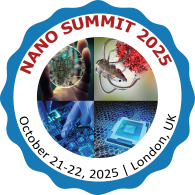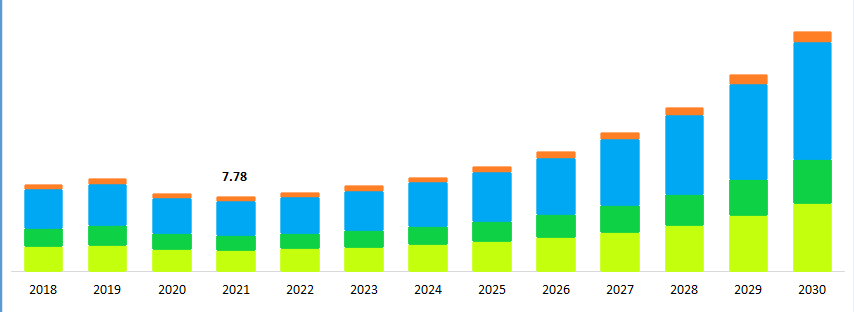Sessions and Tracks
TRACK 1: Nanoscience and Nanotechnology
Nanoscience is the study of phenomena and the manipulation of materials at atomic, molecular, and macromolecular scales, where properties differ significantly from those observed at larger scales. This unique approach allows for the manipulation of materials' shape and size at the nanoscale, enabling the design, characterization, manufacturing, and application of nanoscale structures, devices, and systems. Collectively, these efforts are known as Nanotechnology. Modeling nanoscale materials, objects, and interactions plays a critical role in nanotechnology, as advancing this field relies on a deep understanding of these fundamental interactions. Key areas of research within nanotechnology include:
-
Drug Delivery and Nanoparticles
-
Molecular Nanotechnology
-
Bionanoscience
-
Lipid Nanoparticles
-
Nanofluidics and Nanoionics
-
Nanobiopharmaceutics
TRACK 2 : Nanotechnology in the COVID-19 Pandemic
Nanotechnology has shown great potential in contributing to the efficient regulation and management of COVID-19. By designing materials with precise structures and molecular architectures, nanoscience enables the development of particles ranging from one nanometer to hundreds of nanometers in size. These nanomaterials exhibit unique optical, electrical, and biological properties due to their nanoscale structure. Given the similar scale of activity between nanoparticles and viruses, nanotechnology offers promising applications in vaccine development and immune system modulation. Researchers in nanomedicine have long studied the ability of various nanosystems and viral vectors to deliver genes, which has informed approaches to combatting high infectivity rates in viruses like SARS-CoV-2.
Key applications of nanotechnology in COVID-19 include:
-
Nanotechnology-based vaccines
-
Immunization through delivery of viral biomolecules
-
Nucleic acid-based nanovaccines
TRACK 3: Nanotechnology in COVID-19 Diagnosis
Nanotechnology offers valuable tools for rapid diagnostics, early disease detection, and the identification of infectious pathogens, proving particularly useful in pandemics like COVID-19. Nanobiosensors, for example, enhance both the accuracy and speed of the diagnostic process. With the development of new nanomaterials and nano-fabrication techniques, researchers are focusing on improving the surface area of biosensors to increase sensitivity and reduce detection times compared to traditional methods. Key applications of nanotechnology in COVID-19 diagnostics and management include:
-
Nanosensors for diagnosis
-
Nanoparticles in COVID-19 testing
-
Bio-Nano Interface Technology
-
Nanotherapies for COVID-19 management
-
Biomedical Nanotechnology
-
Advanced Nanomaterials
TRACK 4 : Nanophotonics and Nanoelectronics
Nanophotonics is the study and engineering of light-matter interactions at wavelength and subwavelength scales, where the interactions are influenced by the unique physical, chemical, or structural properties of nanostructured materials. Nanoelectronics, on the other hand, involves applying nanotechnology principles to electronic components. By combining experimental methods, theoretical models, and advanced analysis, the Nanoelectronics and Nanophotonics field seeks to identify and leverage the unique characteristics of nanomaterials for applications in electronics, photonics, and optoelectronics. Nanophotonic devices, in particular, play a critical role in controlling quantum emitter parameters, enhancing their functionality.
TRACK 5: Nanobiotechnology
Nanobiotechnology is an emerging field that examines the unique physical, chemical, and biological properties of nanostructures and explores their applications across sectors like agriculture and medicine. For instance, metal nanoparticles have been found to play a significant role in combating fungal diseases in both plants and humans. In medicine, nanobiotechnology (or nanobiology) enables a shift from symptom management to innovative treatments and even the restoration of biological tissues.
Applications of Nanobiotechnology:
-
Diagnostic Applications
-
Therapeutic Applications
TRACK 6 : Nanosafety
Nanosafety encompasses the tools, methods, and strategies necessary to ensure the safe development and use of nanomaterials. It includes the establishment of policies, standards, and research practices to support responsible nanotechnology applications, particularly in industrial and manufacturing settings. By integrating nanoscale phenomena, nanodevices, and nanoparticle interactions, nanosafety is essential for advancing safe practices in nanotechnology.
Key Areas in Nanosafety:
-
Impact of Nanobiotechnology
-
Regulations of Nanobiotechnology
-
Roller Nanoimprint Technology
-
Bionanoscience
-
Ultrafast Nanoimprint
-
Nanobiomolecular Engineering
TRACK 7: Green Nanotechnology and Water Treatment
Green nanotechnology utilizes natural substances like microorganisms, plants, and organic polymers (such as lipids, proteins, and carbohydrates) to create eco-friendly nanoparticles. These green nanoparticles offer an effective, sustainable solution for purifying water bodies and treating wastewater. In water treatment, nanotechnology serves three main purposes: remediation and purification (through complete or partial removal of contaminants), pollution monitoring (using nanosensors and pollutant-specific detectors), and pollution prevention.
Applications of Nanotechnology in Water Treatment:
-
Nanotechnology in Water Treatment
-
Advanced Water Purification Technologies
-
Nanoremediation for Water Treatment
-
Water Filtration Solutions
-
Nanosorbents for Contaminant Removal
-
Nanotechnology for Disinfection
TRACK 8: Nanoengineering
Nanoengineering is a field focused on researching, designing, and improving materials at extremely small scales. Similar to how mechanical engineering applies the principles of physics, nanoengineering applies nanoscience practically. It emphasizes the interaction of nanoparticles to develop functional materials, structures, devices, and systems. Serving as an enabling technology, nanoengineering has applications across a wide range of industries, including electronics, energy, healthcare, and biotechnology. It involves materials like quantum dots, carbon nanotubes, and nanocomposites.
Key Areas in Nanoengineering:
-
Nanorobotics
-
Nano Devices
-
Nano Sensors
-
Nano Structures
-
3D Printing at the Nanoscale
-
DNA Nanotechnology
TRACK 9: Nanotechnology in Various Fields
Nanotechnology is already incorporated into hundreds of products, from sunscreens and cosmetics to clothing and sports equipment, and remains a key area of global research and development. Beyond consumer goods, nanotechnology is being harnessed in medical fields for innovations such as biosensors and drug delivery systems.
Applications of Nanotechnology Across Different Fields:
-
Household Products
-
Biomedical Sciences
-
Agricultural Research
-
Food Industry
-
Computer Sciences
-
Environmental Sciences
TRACK 10 : Applications of Nanotechnology
Nanotechnology is making transformative impacts across various sectors:
-
Electronics: Carbon nanotubes are replacing silicon in many applications, enabling the creation of quantum nanowires that are lighter, more conductive, and stronger. They allow for the development of smaller, faster, and more efficient microchips and devices. Graphene, with its unique properties, is ideal for creating flexible touchscreens.
-
Energy: A new semiconductor developed at Kyoto University has made solar panels that double sunlight-to-electricity conversion possible. Nanotechnology also contributes to lighter, stronger wind turbines, enhanced fuel efficiency, and energy savings through improved insulation from certain nanocomponents.
-
Biomedicine: Nanomaterials are instrumental in advancing early diagnosis and treatment of cancers and neurological diseases, with the capability to target cancer cells precisely while sparing healthy ones. Additionally, nanoparticles are used to enhance products like sunscreens, making them more effective.
-
Environment: Eco-friendly nanotechnology applications include heavy metal nanofiltration systems, nitrogen-compressed wastewater treatment, and ion-based air purification. Nano-catalysts are also used to make chemical reactions more efficient and less polluting.
-
Food Industry: Nanocomposites and nanobiosensors in food packaging help reduce oxygen transfer, enhance mechanical and thermal resistance, and detect pathogens in food, thereby improving food safety and shelf life.
-
Textiles: Nanotechnology enables the production of stronger, lighter, and more durable materials for applications like sports equipment and helmets, as well as "smart" fabrics that are wrinkle- and stain-resistant.
TRACK 11: Nanotoxicology
Nanotoxicology is the branch of toxicology that focuses on the study of the toxicity of nanomaterials, which can either be synthetically produced through processes like spray drying or grinding, or occur naturally. This field is essential for understanding the potential harmful effects of nanoparticles on both the environment and human health. One of the key challenges in nanotoxicology research is improving the presentation of data, particularly in test item characterization, for toxicological and scientific journals.
Key Areas in Nanotoxicology:
-
Toxicological Assessment of Manufactured Nanoparticles
-
Effects of Nanotoxicology on Nanomaterials
-
Impacts of Nanoparticle Design in Nanotoxicology
-
Different Types of Nanotoxicology
-
Reducing Toxicity While Maintaining Therapeutic Effects
TRACK 12 : Carbon Nanotechnology
Carbon Nanotechnology focuses on providing up-to-date insights and analyses from leading experts, highlighting the latest advancements in this rapidly evolving field. As a driving force behind emerging nanotechnologies, carbon nanotechnology has become an interdisciplinary domain, blending aspects of chemistry, physics, biology, medicine, materials science, and engineering. Carbon nanotubes, known for their exceptional strength and unique structural and electrical properties, are one of the most promising materials with broad applications across various industries.
Key Areas in Carbon Nanotechnology:
-
Formation and Characterization of Carbon Nanotubes
-
Properties of Carbon Nanotubes
-
Polymer-Carbon Nanocomposites for Sensors
-
Purification and Separation of Carbon Nanotubes
-
Nano Electron Emitters
-
Molecular Electronics
TRACK 13 : Nanometrology
Nanometrology is the science of measurement at the nanoscale, focusing on ensuring high precision and reliability in the production of nanomaterials and devices. This field is critical for the advancement of nanotechnology, as it allows for the accurate characterization and manipulation of materials at the nanoscale. The progress of nanometrology directly impacts the recognition and success of nanotechnology across various industries. Nanometrology has found applications in a wide range of scientific disciplines, including biology, medicine, and environmental science. The development of tools such as optical tweezers, scanning probe techniques, and electron beam methods has been crucial to its advancement.
TRACK 14: Environmental Nanotechnology
Environmental nanotechnology is seen as a key component in developing effective solutions for various environmental engineering and science challenges. The field focuses on addressing global environmental issues by applying nanotechnology to improve systems, enhance monitoring tools, generate renewable energy, and remediate environmental pollutants. While nanotechnology has advanced rapidly, its role in environmental protection is still evolving, with ongoing research and gradual implementation in real-time applications.
Key Applications of Environmental Nanotechnology:
-
Nano-Enabled Treatment Technologies
-
Nano-Sensors for Biological and Chemical Contamination
-
Nanomaterials for Water, Soil, and Air Remediation
-
Nanopollutants
-
Environmental Monitoring with Nanotechnology
TRACK 15: Pharmaceutical Nanotechnology
Nanotechnology is a rapidly growing and innovative field in pharmaceuticals and medicine. In particular, nanoparticles offer significant advantages as drug delivery vehicles, enhancing drug efficacy while reducing adverse reactions. Pharmaceutical nanotechnology is instrumental in developing advanced drug delivery systems, serving as a powerful alternative to traditional dosage forms. By identifying disease-related antigens and pathogens, nanotechnology plays a critical role in the fight against various diseases. It also helps overcome the limitations of conventional dosage forms, such as tablets.
Applications of Pharmaceutical Nanotechnology:
-
Drug Delivery Systems
-
Tissue Engineering
-
Gene Therapy
-
Molecular Diagnosis
-
Stem Cell Therapy
-
Cancer Treatment
-
Drug Discovery
TRACK 16: Energy and Environment
Research in energy and the environment focuses on developing clean and renewable energy solutions, as well as the effective production, storage, and utilization of energy and natural resources. It also examines the interactions between energy technologies and the environment. Understanding how renewable energy systems impact natural resources is key to achieving sustainability. This area of study is closely linked to two main themes: Sustainable Environmental Systems and Efficient & Clean Energy Systems.
Key Areas in Energy and Environment Research:
-
Nonnuclear Materials
-
Oil & Gas
-
Nano-Energy
-
Nano Solar Cells
-
Nanofuels
-
Nano Batteries
-
Nanofibers
-
Advanced Energy Storage Technologies
TRACK 17: Nanocharacterization
Nanocharacterization is a branch of nanometrology that focuses on identifying and measuring the physical and chemical properties of nanoparticles. Nanoparticles are typically engineered for their unique characteristics and have at least one dimension smaller than 100 nanometers. This process is essential for various applications, including evaluating occupational exposure to assess health and safety risks, conducting nanotoxicology research, and monitoring process control in nanotechnology.
Key Areas in Nanocharacterization:
-
Nano Tribology
-
Nano Sensors and Actuators
-
Nanoscale Particle Microscopy
-
Quality Assessment of Nanosystems
-
Regulatory Aspects in the Approval of Nanomedicines and Nanostructures
TRACK 18: Life Sciences and Nanomedicine
Nanotechnology is an emerging field with great potential to provide technological solutions and commercially viable products across a range of application areas. In the life sciences, nanotechnology is being utilized in pharmaceuticals, biotechnology, medical devices, diagnostics, gene therapy, drug delivery, and tissue engineering. It holds significant promise for improving drug delivery systems. Key applications include vaccine adjuvants and delivery systems, nanostructured materials for orthopedics and wound management, controlled-release drug delivery systems, drug delivery vehicles that enhance circulation and target specific cells, and methods to increase the solubility of poorly water-soluble drugs. These advancements are paving the way for more effective and efficient medical treatments.
TRACK 19: Nanochemistry and Wet Nanotechnology
Nanochemistry is a rapidly growing branch of chemistry, especially solid-state chemistry, focused on the development of materials with nanometer-scale dimensions. This emerging field within chemistry and materials science explores new methods for synthesizing nanoscale materials, which are applied in a variety of industries including electronics, nanodevices, composite materials, biotechnology, medicine, and textiles.
Wet nanotechnology, unlike dry nanotechnology, relies on water as the medium for its processes. This field involves chemists and biologists working together to combine molecules to create larger structures. While Eric Drexler initially proposed the concept of dry nano-assemblers, wet nanotechnology is viewed as the more practical and economically viable area for realizing nano-assemblers in the near future. Wet nanotechnology is closely related to wet engineering, where biological systems, typically operating in aqueous environments, are central to the research. Since water constitutes most of our bodies, biologists use wet nanotechnology to study processes that occur in living organisms, making it a vital area of exploration within nanotechnology.
TRACK 20: Nanocomputational Modelling
Nanocomputational modelling, a subfield of nanotechnology, focuses on developing and utilizing computer-based models to understand, analyze, and predict the behavior and properties of nanoscale systems. It offers valuable insights into both existing and emerging approaches, highlighting opportunities and challenges related to computational tools used in nanoscience research.
Key Areas in Nanocomputational Modelling:
-
Computational Modelling of Photonic Nanomaterials and Devices
-
Catalytic Cycles and Reactions
-
Stochastic Motion of Nanomotors
-
Optimization of Nanostructures
-
Molecular Modelling and Simulation of Nanoscale Systems
-
Foundations of Nanoscale Physics and Modelling










